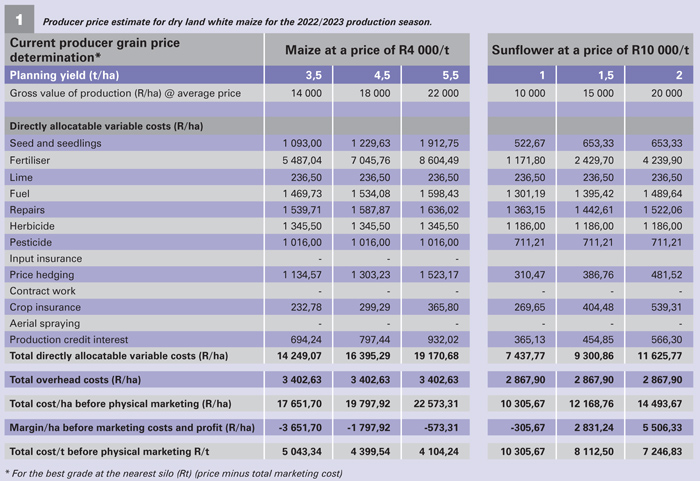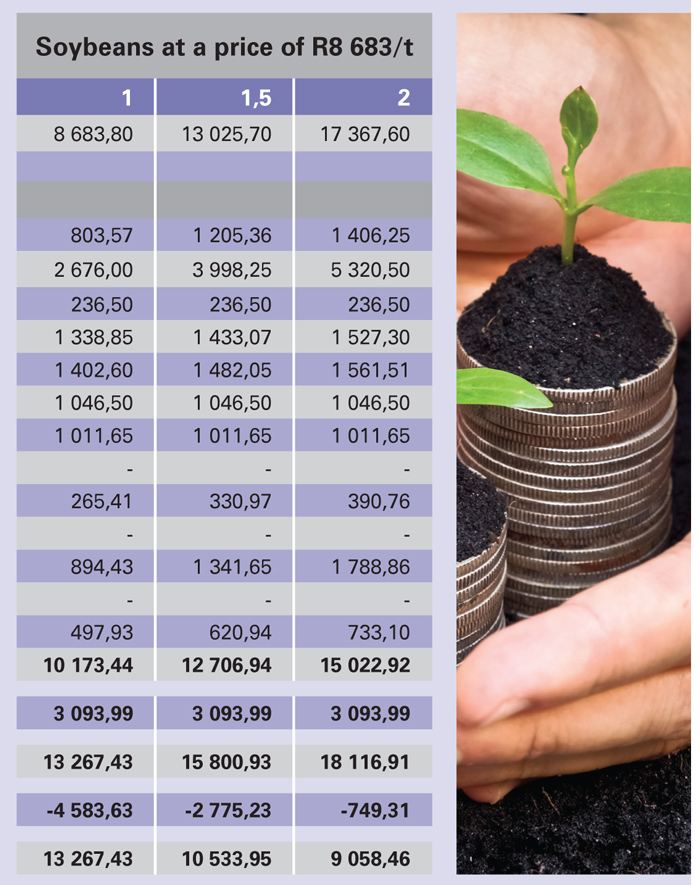August 2022
| CHRISTIAAN VERCUIEL, INTERN: APPLIED ECONOMICS, GRAIN SA AND PIETMAN BOTHA, INDEPENDENT AGRICULTURAL CONSULTANT |
 |
Farming can no longer be seen as just the physical work being done to produce the crop. In modern times farming must be seen as a business and therefore run like a business. Strict rules need to be established and followed to ensure that farmers can produce profitably and are able to plant during the next season.
Planting can be a time-sensitive game and choosing the correct planting window can be tricky, but when is it practical not to plant? To answer this question, you have to look at input costs and income.
INPUT COSTS
These costs are defined as the set of costs needed to create a product or service. It includes all costs incurred by a business that are related to general and administrative activities. To make it more applicable to agriculture, input costs are defined as all costs related to the production and harvesting of crops such as fuel, fertiliser and agricultural chemicals.
Input costs can be divided into two different categories:
Fixed cost does not change with an increase or decrease in the number of goods and services produced or sold. In agricultural terms it can be said that these are costs that a farmer has to pay regardless of whether or not he produces. These are monthly or annual costs such as electricity line hire, rent, salaries and the cost of living – expenses which will remain the same on a monthly or yearly basis.
Variable cost changes in proportion to how much a company produces or sells. In agricultural terms it can be said that this is a cost that increases if production increases. These costs will increase or decrease as production increases or decreases. Examples of these are fuel, seed, agricultural chemicals and fertiliser.
In short, total cost = variable cost + fixed cost. In farming terms, the total cost to produce the crop is equal to the overhead expenses such as rent, upkeep, electricity line hire, levies and taxes, plus the expenses such as the cost of seed, fertiliser, fuel and agricultural chemicals.
INCOME
Income is the amount of money or property received for goods sold or services delivered. It can be divided into two categories:
Gross income, which is an individual’s total earnings before taxes and other expenses. For agriculture, gross income is the total amount of money that a farmer receives for the product that he produces and delivers.
Net income can also be referred to as profit. It is the income after all expenses have been subtracted. Expenses include all expenses incurred such as taxes, fuel, levies, fertiliser and subtractions.
Net income = gross income - expenses
WHEN IS IT NOT VIABLE TO PLANT?
The goal of any farmer should be to produce products in such a way that he can cover the cost of his crop and living expenses; and have enough left to either plant the crop cash, or to serve as an asset which helps him to get a loan.
Farmers should therefore use the following equation to test the viability of planting:
Profit/loss = income - expenses
In farming terms, this means that net income (profit) is equal to the money a farmer receives from selling his product minus the cost of production.
Criteria to determine if it is viable to plant
In short, to calculate if it is viable to plant:
It is very important for farmers to do their homework properly before they commit to planting a crop. This means that the farmer must be accurate in his prediction of costs and income, as an inaccurate prediction of these concepts can lead to inefficiency and loss.
HOW MUCH IS IT GOING TO COST TO PLANT A HECTARE?
In Table 1 the production cost for maize, sunflower and soybeans for different yields in North West is shown. Please note that this is only an example as prices of fertiliser, herbicide, pesticide and fuel can still change before planting. Every farmer should compile his own budget before making the decision to plant.
According to Table 1 the price for a 3,5 ton yield should be at least R5 043,34. At a 5,5 ton yield, a farmer can break even as the production cost per ton is close to the price per ton. For sunflower
1 t/ha is close to breaking even, but for 2 t/ha there is some profit. If a farmer is going to plant soybeans using fertiliser (or do fertiliser corrections the year after planting), the profitability of soybean production will be under pressure.


Publication: August 2022
Section: Pula/Imvula